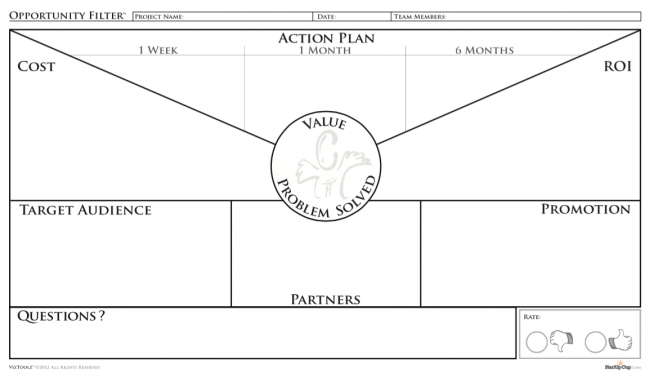Opportunity Filter

What is this?
You’ve got what you think is a great idea, now what? The Opportunity Filter is a Viztool or visual tool that supports validating new ideas and enhance critical thinking about the necessary steps required to move an idea forward.
When is this tool used?
This tool is used when entrepreneurs want to evaluate their ideas. Using a structured process can help them come with the feasibility of each idea and how worth is it.
How is this tool used?
Post The Opportunity Filter on a wall or on a table so that brainstorming participants can walk up to the mural and post ideas as they are generated. Bring a variety of colored sticky notes and distribute to team members participating. You will want to come up with as many ideas as possible for each section. We recommend working through The Opportunity Filter in the following order:
Step 1 (Problem solved):
Think critically about the value potentially created by the new idea. Think in terms of tangible and intangible value. Does the value sup- port a strategic direction or organizational goals and objectives? Define what problem is being solved, if there is a problem.
Step 2 (Target audience):
Identify the target audience(s) for the new idea. Who is the primary audience? There can be more than one audience.
Step 3 (Partners):
Identify potential strategic partners who can help accelerate taking the idea forward? Focus on skills and accessibility.
Step 4 (Promotion):
- How are you going to reach the target audience(s)?
- Who will be leading the marketing and promotions activities?
- What are the key messages to grab the attention of the target audience(s)?
Step 5 (Cost):
- Think about all the costs associated with moving the idea forward.
- Think through internal / external resource requirements.
- Are volunteers required to get started? How many? What time required?
Step 6 (Calculate the Return on Investment (ROI)):
- Does the idea meet strategic objectives and/or organizational goals?
- Estimate how much revenue will be generated.
- What kind of media exposure will the idea generate?
Step 7 (Action Steps to move the Idea to Reality):
Think in terms of overarching steps, 1 week, 1 month, 6 month timeframes.
Step 8 (Further questions):
Think through unanswered questions and if anything is missing.
Hints for using this tool
Once the entire Opportunity Filter is filled out, review each section and remove any ideas that on second pass do not make the final cut. Leave only the strongest ideas developed for each section. Now, with a cautiously optimistic frame of mind, rate the idea based upon a 1=weak to 5=strong rating system.
Case study
Person X wants to start their own company, which provides financial consulting services for SMEs, and invites potential partners for a brainstorming session. They post the Opportunity Filter on a wall or on a table so that brainstorming participants can walk up to the mural and post ideas as they are generated.
Problem solved:
The problem being solved is helping small and medium enterprises, who usually don’t have enough experience, make right financial decisions. The added values are tangible in a sense, because they will get a financial compensation for becoming financial advisors, and also intangible as with time, they shall have a good reputation/standing in the market.
Target Audience:
The primary audience is medium/small enterprises including entrepreneurs/startups owners, and other business forms.
Partners:
Potential strategic partners might include legal or auditing firms, which have complementary skills, and will be interested in a collaboration to serve both parties and accelerate the idea implementation.
Promotion:
After segmenting the SMEs audience, key messages have to be defined (E.g. Our company aims to provide affordable financial advising, we help you to grow big, etc).
The optimum promotion mix has to be chosen(e.g advertising, PR, and direct marketing to pitch certain identified clients etc), along with the campaign leader ( or the outsourcing company who shall execute it, if needed)
Cost:
After coming up with the idea, and defining basic steps for business plan, it is essential to take it to the next step and answer the question: How realizable is this idea?
All costs associated have to be mentioned, in addition to estimates of needed external/internal resources. This can include estimates fixed and variable costs, and fees for legal procedures etc. It is also beneficial to consider how many people are needed to start taking the idea forward
Calculate the Return on Investment:
Next, it is recommended to match the idea with the strategic objectives and/or organizational goals, and see how close they are to achieving them, and also estimating how much revenue will be generated.
Action Steps to move the Idea to Reality:
The only thing missing at this point is creating a timeline; with time estimates to achieve every step, and short term and long term goals.
For example: estimating that the company will be officially licensed within six month, and shall start operating in a year, while promotion campaign has to start as early as company gets registered.
Short-term goals might include the number of clients to be achieved or a certain financial target.
Further questions:
This step takes back to all previous steps to tackle any unanswered matter or rethink any suggestion




































































EgyptInnovate site is not responsible for the content of the comments